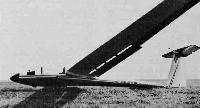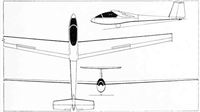
Варианты
- ICA-Brasov - IS-28 / IS-29 - 1970 - Румыния
- ICA-Brasov - IS-28M / IAR-34 / IAR-46 / IAR-48 - 1976 - Румыния
M.Hardy. Gliders & Sailplanes of the world
ICA-Brasov IS-28B2
Developed from the IS-28 two-seater high performance training sailplane of 1970, which first flew in August of that year, the IS-28B2 has a number of important differences from the earlier design which include 17m span all-metal mid wings of Wortmann section instead of the IS-28's 15m span shoulder wings of NACA section, a longer and more slender fuselage and reduced wing and tailplane dihedral. Design work on the IS-28B began in the autumn of 1971 and the prototype made its first flight on 26 April 1973. The first production version was the IS-28B1 which did not have wing flaps, but this has now been succeeded by the IS-28B2 which has trailing edge split flaps and Schempp-Hirth air brakes instead of the DFS-type ones of the B1. About 100 IS-28B2s have been sold so far, and a high proportion of this total have gone to customers in Australia and the USA. Both versions are of all-metal construction, as was the earlier IS-28, and the forward-swept wings have L-section main spar booms and dural spar webs, a dural auxiliary spar and dural ribs. The Schempp-Hirth air brakes above and below the wings are metal, whereas the ailerons and flaps are fabric covered except for their leading edges. The wings are attached to the fuselage by two adjustable tapered bolts at the leading edge and two fixed tapered bolts at the trailing edge. The forward and centre fuselage is an all-metal semi-monocoque structure, while the rear fuselage is a duralumin monocoque. The two pilots are seated in tandem under a one-piece Plexiglas canopy which opens sideways to starboard and can be jettisoned in flight. A nose towing hook with Tost cable release is standard, but a towing hook mounted on the cg is an optional choice for the customer. The folding cantilever all-metal T-tail is similar to the IS-28's but has a single-spar fin; the elevator trailing edges and rudder are fabric covered and there is a trim tab in each elevator. The landing gear consists of a semi-retractable monowheel with a disc brake and oleo-pneumatic shock absorber, and there is a sprung tailskid.
A new Open Class development of the IS-28B2 known as the IS-30 was undergoing flight tests in the spring of 1978; this has 18m (59ft 0 3/4 in) span wings without provision for water ballast, and the redesigned tail unit of the IS-32.
Data: IS-28B2
Span: 55 ft 9 1/4 in
Length : 27 ft 5 1/4 in
Height: 5 ft 10 3/4 in
Wing area: 196.3 sqft
Aspect ratio: 15.8
Empty weight :826 lb
Max weight: 1,300 lb
Max speed: 140 mph (in smooth air)
Min sinking speed: 2.26 ft/sec at 45 mph
Best glide ratio: 34:1 at 62 mph
ICA-Brasov IS-29
The IS-29, designed by a team under Dipl Ing Iosif Silimon, is an attempt to create a multi-role high performance single-seater suited to a variety of requirements and soaring conditions, and is offered in Standard Class (IS-29B and IS-29D) versions with 15m span wings, in Open Class form as the IS-29E with increased span wings and the IS-29G for club use with 16.5m span wings. All versions have an identical fuselage and tail unit, differing mainly in the wing fitted, and are basically similar to the IS-28B2 with the same all-metal construction and a similar T-tail. The IS-29B Standard Class version with 15m span all-wooden wings was the first to fly, in April 1970, and was certificated in September that year; the prototype has a three-piece wing with constant chord centre section and tapered outer panels, and 'salmon' fairings on the wing tips. The IS-29B was succeeded by the Standard Class IS-29D which had all-metal wings of the same span and first flew in November 1970. About 30 had been built by 1974 and from 1976 the current production version has been the IS-29D2, which features an improved cockpit and controls, Hutter air brakes, a separate tailplane and elevator instead of the earlier all-moving tailplane, and an improved rigging system. More than 60 of this variant have been sold in Australia and the USA and the IS-29D4, which appeared in 1977, had provision for water ballast. The Open Class IS-29E first flew in August 1971 with wings increased in span to 17.60m (57ft 9in), and fitted with flaps and Schempp-Hirth air brakes as well as integral water ballast tanks. The current production version of the E is the IS-29E3, also known as the IS-31,with 20m (65ft 7 1/2 in) span wings, and a 19m span (62ft 4in) version, the IS-29E2, was under development in 1977, while the IS-29E4 is a 24m span version. The club version is the IS-29G, also known as the IS-29D3, which has all-metal 16.5m span (54ft 1 1/2in) wings; this first flew in 1972, and the E2 and E3 variants have slightly different Wortmann wing sections to those of the IS-29D2. All versions except the IS-29B have all-metal shoulder wings with a main spar, false rear spar and riveted dural skin. The full-span flaps and ailerons are coupled to operate in unison but the flaps can be disconnected for separate operation during landing. The D2's Hutter air brakes are in the upper surface of the wings only, those of the other models being in the upper and lower surfaces. The all-metal semi-monocoque fuselage is the same for all versions except for local variations at the wing attachment points, and there is a detachable glassfibre nosecap. The retractable monowheel has a brake and there is a fixed tailwheel. The cockpit canopy hinges sideways to starboard and can be jettisoned in flight.
The IS-29D3 Club version has a fixed undercarriage and unpainted (all-chrome) finish. The IS-29D4 15m Class version has a maximum flap setting of 80° and air brakes, and will later be offered with 26.4 Imp gallons of water ballast.
The IS-29E2 19m span version has interconnected flaps and ailerons, and will be offered with 22 Imp gallons of water ballast. The IS-29E4 has a wing of 24m span made in four sections, with interconnected flaps and ailerons, and carries water ballast.
The IS-29DM and IS-29EM each have a 39hp Rectimo 4AR-1200 engine driving a Hoffman HO-V42 propeller; the fuel capacity is 6 Imp gallons. A retractable tubular-sprung Tost monowheel is fitted to these versions, plus a Tost tailwheel. Production IS-29DMs and IS-29EMs were due to become available from mid-1980.
The IS-33 racing version has interconnected flaps and ailerons on its 15m span wings, and is to be offered with 33 Imp gallons of water ballast.
The IS-31(E3) is a version of the IS-29 with 20m span wings and interconnected flaps and ailerons; it will be offered with 33 Imp gallons of water ballast. The prototype has flown but had not been certificated by mid-1979.
Data: IS-29D2
Span: 49 ft 2 1/2 in
Length: 24 ft 2 1/2 in
Height: 5 ft 6 1/4in
Wing area: 111.9 sq ft
Aspect ratio: 21.6
Empty weight: 518 lb
Max weight :794 lb
Max speed: 155 mph (in smooth air)
Min sinking speed: 1.41 ft/sec at 50 mph
Best glide ratio: 48:1 at 58 mph
ICA-Brasov IS-32 Romania
First shown publicly at the Paris Air Show in June 1977, and making its first flight that same month, the IS-32 Open Class tandem two-seater is developed from the IS-28B2, having the same fuselage as the latter married to an entirely new wing of 20m (65ft 7 1/2in) span with an improved aerofoil section, and a redesigned tail unit. The interconnected flaps and ailerons are also known as 'flaperons', the flaps working in conjunction with the ailerons in negative position for high speed cruising, and in the positive position for soaring in thermals, being disconnected for landing. Like the IS-28B2, Schempp-Hirth metal air brakes are fitted above and below each wing and there are water ballast tanks. A new landing gear is fitted, the main monowheel now being fully retractable instead of semi-retractable as on the IS-28B2. The one-piece tailplane has a new thinner section aerofoil. The IS-32 is of the same all-metal construction as the IS-28B2,and deliveries were due to commence late in 1978.
Span: 65 ft 7 1/2 in
Length: 27 ft 5 1/4 in
Height: 6 ft 0 3/4 in
Wing area: 158.0 sq ft
Aspect ratio: 27.2
Empty weight: 771 Ib
Max weight: 1,300 lb
Max speed: 144 mph
Min sinking speed: 1.74 ft/sec at 53 mph
Best glide ratio: 46:1 at 61 mph
Описание:
- M.Hardy. Gliders & Sailplanes of the world
- Jane's Encyclopedia of Aviation
Фотографии
-
Jane's All the World Aircraft 1976 / 03 - Sailplanes
ICA-Brasov IS-28 tandem two-seat training sailplane
-
Jane's All the World Aircraft 1974 / 03 - Sailplanes
ICA-Brasov IS-28 tandem two-seat training sailplane
-
Jane's All the World Aircraft 1976 / 03 - Sailplanes
Регистрационный номер: YR-1003 IS-28B tandem two-seat high-performance training sailplane
-
Air Enthusiast 1998-03 / D.Vlad - Out of the Ashes
Регистрационный номер: YR-317 IS-28B2 YR-317, May 1994.
-
Jane's All the World Aircraft 1974 / 03 - Sailplanes
IS-29B single-seat Standard Class 15 m sailplane produced by ICA-Brasov
-
Jane's All the World Aircraft 1976 / 03 - Sailplanes
IS-29B single-seat Standard Class sailplane produced by ICA-Brasov
-
Jane's All the World Aircraft 1974 / 03 - Sailplanes
IS-29D single-seat Standard Class 15 m sailplane produced by ICA-Brasov
-
Jane's All the World Aircraft 1976 / 03 - Sailplanes
Регистрационный номер: YR-1006 IS-29D single-seat Standard Class sailplane produced by ICA-Brasov
-
Jane's All the World Aircraft 1974 / 03 - Sailplanes
Регистрационный номер: YR-1005 [2] IS-29E single-seat high-performance Open Class sailplane, with 17 6 m span all-metal wings
-
Jane's All the World Aircraft 1975 / 03 - Sailplanes
Регистрационный номер: YR-1005 [2] IS-29E single-seat high-performance Open Class sailplane, with 17-6 m span all-metal wings
-
Jane's All the World Aircraft 1976 / 03 - Sailplanes
IS-29G, club version ot this design by Dipl Ing Silimon, with 16.5 m span all-metal wings
-
Jane's All the World Aircraft 1974 / 03 - Sailplanes
IS-29G, club version of this design by Dipl Ing Silimon, with all-metal 16 5 m span wings
-
Jane's All the World Aircraft 1974 / 03 - Sailplanes
IS-28B tandem two-seat high-performance training sailplane
- Фотографии














